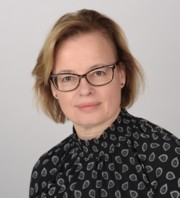Hurvitz Brain Sciences Program
SRI programs

Senior scientist
Dixon Family Chair in Ophthalmology
Sunnybrook Health Sciences Centre
2075 Bayview Ave., Room A3 20C
Toronto, ON
M4N 3M5
Administrative Assistant: Cassandra Cheng
Phone: 416-480-6100 ext. 63537
Email: cassandra.cheng@sunnybrook.ca
Education:
- B.Sc., 1986, psychology, University of Alberta, Canada
- B.Sc. Special Certificate, 1987, microbiology, University of Alberta, Canada
- M.Sc., 1990, microbiology, University of Alberta, Canada
- PhD, 1995, medical genetics, University of Toronto, Canada
- Postdoctoral fellowship, 2001, Institut de Génétique et de Biologie Moléculaire et Cellulaire, Strasbourg, France
Appointments and Affiliations:
- Senior scientist, Biological Sciences, Hurvitz Brain Sciences Research Program, Sunnybrook Research Institute
- Professor, department of biochemistry, department of laboratory medicine and pathobiology, department of ophthalmology and vision sciences, University of Toronto
- Adjunct professor, department of biochemistry and molecular biology, University of Calgary
Research Foci:
- Neural development, with a focus on the retina and neocortex
- Neuonral reprogramming, with a focus on cortical astrocytes and retinal Müller glia
- Transcriptional regulation of neural cell fate specification
Research Summary:
The focus of Dr. Schuurmans’ research is on the specification of neural cell fates and the control of tissue morphogenesis in the developing central nervous system, in particular in the developing retina and neocortex. She is applying her knowledge of neural development to understand the injury response and to mobilize endogenous glial cells for tissue repair. Her lab is also developing lineage conversion strategies for neuronal cell replacement therapies.
Selected Publications:
See current publications list at PubMed.
- Han S, Okawa S, Wilkinson G, Gazalah H, Adnani L, Dixit R, Tavares L, Faisal I, Brooks M, Cortay V, Zinyk D, Li S, Malik FU, Angarica VE, Chinchalongporn V, Sivitilli A, Gao J, Oproescu AM, Vasan L, Touahri Y, David LA, Raharjo E, Ilnytskyy Y, Kim J-W, Wu W, Rahmani W, Kovalchuk I, Chan JA, Attisano L, Kurrasch D, Dehay C, Swaroop A, Castro DS, Biernaskie J, del Sol A, Schuurmans C. 2021. Proneural genes define ground state rules to regulate neurogenic patterning and cortical folding. Neuron. Sept. 15;109(18):1-17
- Touahri Y, Dixit R, Kofoed RH, Miloska K, Park E, Raeisossadati R, Markham-Coultes K, David LA, Rijal H, Zhao J, Lynch M, Hynynen K, Aubert I, Schuurmans C. 2020. Focused ultrasound as a novel strategy for noninvasive gene delivery to retinal Müller glia. Theranostics. 2020 Feb 10;10(7):2982-2999. doi: 10.7150/thno.42611. eCollection 2020. PMID:32194850
- *Han S, *Dennis D, *Balakrishnan A, Dixit R, Britz O, Touahri Y, Olender T, Brand M, Zinyk D, Guillemot F, Kurrasch D, Schuurmans C. 2018. A non-canonical role for the proneural gene Neurog1 as a negative regulator of neocortical neurogenesis. Development. 2018 Oct 1;145(19). 1-13. pii: dev157719. doi: 10.1242/dev.157719. PMID: 30201687
- *Tachibana N, *Touahri Y, Dixit R, David LA, Adnani L, Cantrup R, Aavani T, Wong RO, Logan CC, Kurek K, Schuurmans C. 2018. Hamartoma-like lesions in the mouse retina: an animal model of Pten hamartoma tumour syndrome. Disease Models and Mechanisms. 2018 May 21;11(5):1-13. pii: dmm031005. doi: 10.1242/dmm.031005. PMID: 29716894
- *Dennis D, *Wilkinson G, *Li S, Dixit R, Adnani L, Balakrishnan A, Han S, Kovach C, Gruenig N, Kurrasch D, Dyck R, Schuurmans C. 2017. Neurog2 and Ascl1 together regulate a postmitotic derepression circuit to govern laminar fate specification in the neocortex. Proc Natl Acad Sci U S A. 2017 Jun 20;114(25):E4934-E4943. doi: 10.1073/pnas.1701495114. PMID:28584103.
Related News and Stories:
- Sunnybrook-led research team awarded $24M grant to develop approach to reprogram brain cells (April 25, 2023)
- Research team discovers new underlying genetic mechanism that drives brain folding: Sunnybrook researchers have discovered a new genetic mechanism that is helping to unlock the mystery of how the brain folds. (August 17, 2021)
- Student among first selected for Amgen Scholars Canada Program: Prestigious program offers students 10 weeks of hands-on research experience, participation in professional development sessions and a $5,000 stipend (June 13, 2019)
- A cut above: Amid funding pressures, SRI scientists post stellar results (Feb. 1, 2019)
- What determines the specific identities of brain cells?: Study zeroes in on the importance of two genes (SRI Magazine, 2018)
- Granted the means to advance novel health research ventures: Sunnybrook Research Institute scientists receive almost $9 million via Canadian Institutes of Health Research grant competitions (July 24, 2018)
- Resounding approval: Dr. Carol Schuurmans, a senior scientist in the Hurvitz Brain Sciences Research Program and Dixon Family Chair in Ophthalmology, is part of a team led by SRI senior scientist Dr. JoAnne McLaurin that was awarded a CIHR Project grant. Along with Dr. Bojana Stefanovic, a senior scientist in Physical Sciences, they will study a treatment strategy for Alzheimer’s disease that aims to balance the neuronal network by converting supportive central nervous system cells into inhibitory neurons. (Jan. 25, 2018)
- Q&A: Dr. Carol Schuurmans (SRI Magazine, 2017)
- Sunnybrook recruits leading neuroscientist in ophthalmology research: New collaborations at SRI will help translate findings (Sept. 30, 2016)
Related Links:


